Analyzing the Benefits of Diversity in the Workplace
VerifiedAdded on 2021/05/30
|10
|2757
|61
Essay
AI Summary
This essay examines the critical role of diversity in the workplace, emphasizing its positive impact on teamwork, innovation, and overall business success. The essay highlights how a diverse workforce fosters flexibility, enabling companies to adapt to market changes and gain a competitive advantage. It explores the benefits of employee collaboration, communication styles, and cultural understanding in creating an inclusive environment. The essay also delves into the importance of diversity training programs, fairness in the workplace, and the development of problem-solving skills. The analysis demonstrates how diverse teams contribute to technological innovations, enhanced customer service, and the ability to engage with the community, ultimately leading to increased productivity and market share. The essay concludes by underscoring the significance of diversity in building effective teams that drive business growth and sustainability.
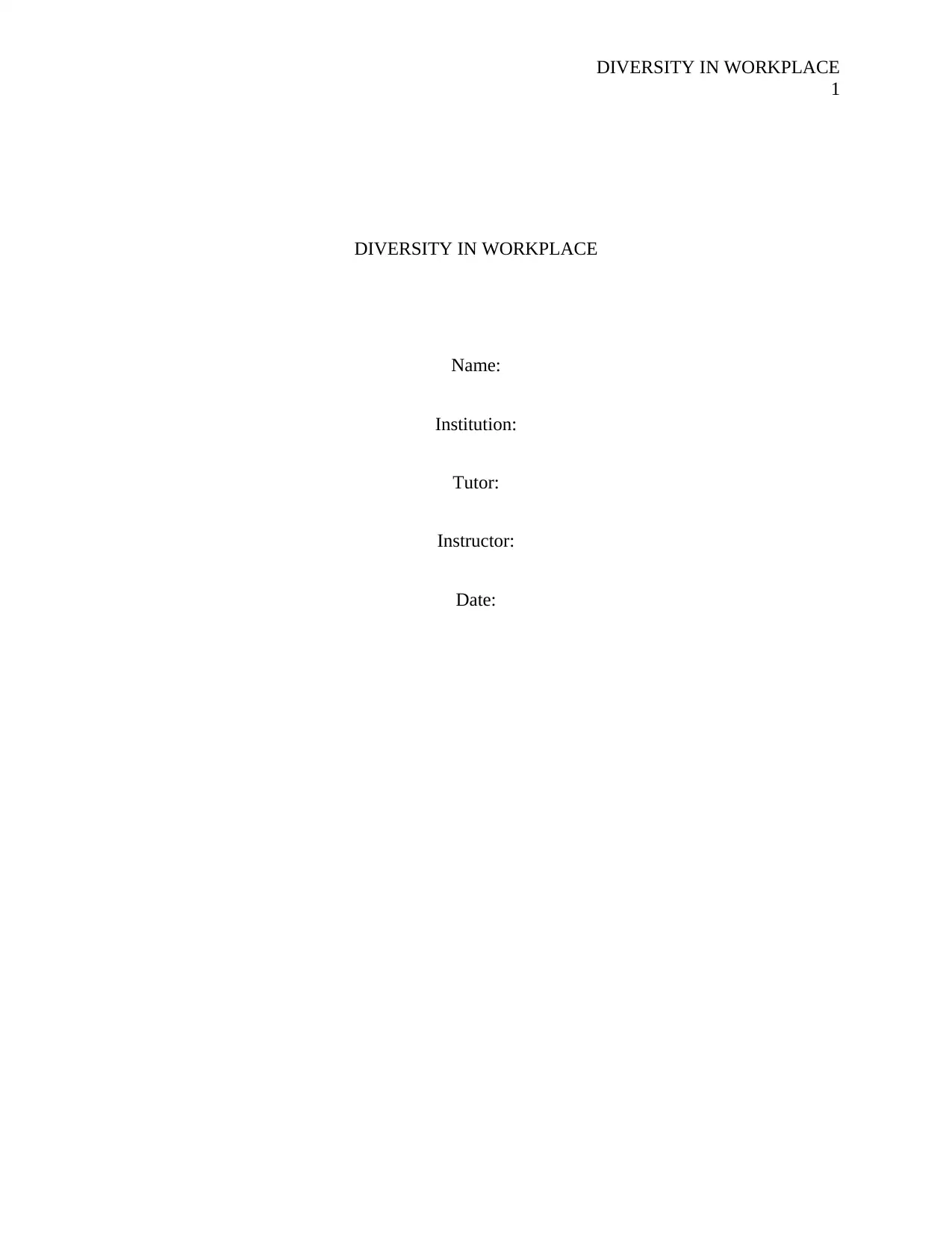
DIVERSITY IN WORKPLACE
1
DIVERSITY IN WORKPLACE
Name:
Institution:
Tutor:
Instructor:
Date:
1
DIVERSITY IN WORKPLACE
Name:
Institution:
Tutor:
Instructor:
Date:
Paraphrase This Document
Need a fresh take? Get an instant paraphrase of this document with our AI Paraphraser
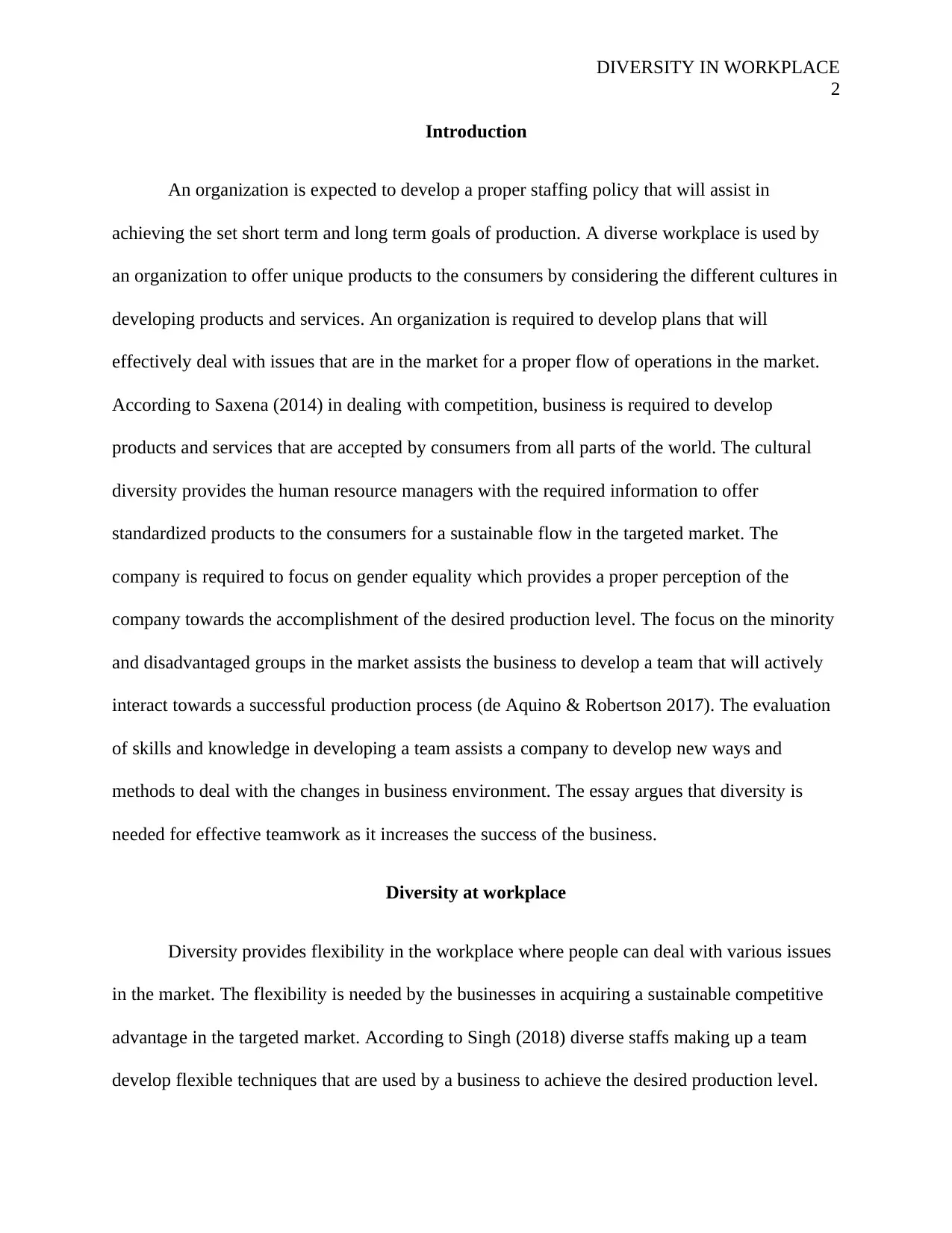
DIVERSITY IN WORKPLACE
2
Introduction
An organization is expected to develop a proper staffing policy that will assist in
achieving the set short term and long term goals of production. A diverse workplace is used by
an organization to offer unique products to the consumers by considering the different cultures in
developing products and services. An organization is required to develop plans that will
effectively deal with issues that are in the market for a proper flow of operations in the market.
According to Saxena (2014) in dealing with competition, business is required to develop
products and services that are accepted by consumers from all parts of the world. The cultural
diversity provides the human resource managers with the required information to offer
standardized products to the consumers for a sustainable flow in the targeted market. The
company is required to focus on gender equality which provides a proper perception of the
company towards the accomplishment of the desired production level. The focus on the minority
and disadvantaged groups in the market assists the business to develop a team that will actively
interact towards a successful production process (de Aquino & Robertson 2017). The evaluation
of skills and knowledge in developing a team assists a company to develop new ways and
methods to deal with the changes in business environment. The essay argues that diversity is
needed for effective teamwork as it increases the success of the business.
Diversity at workplace
Diversity provides flexibility in the workplace where people can deal with various issues
in the market. The flexibility is needed by the businesses in acquiring a sustainable competitive
advantage in the targeted market. According to Singh (2018) diverse staffs making up a team
develop flexible techniques that are used by a business to achieve the desired production level.
2
Introduction
An organization is expected to develop a proper staffing policy that will assist in
achieving the set short term and long term goals of production. A diverse workplace is used by
an organization to offer unique products to the consumers by considering the different cultures in
developing products and services. An organization is required to develop plans that will
effectively deal with issues that are in the market for a proper flow of operations in the market.
According to Saxena (2014) in dealing with competition, business is required to develop
products and services that are accepted by consumers from all parts of the world. The cultural
diversity provides the human resource managers with the required information to offer
standardized products to the consumers for a sustainable flow in the targeted market. The
company is required to focus on gender equality which provides a proper perception of the
company towards the accomplishment of the desired production level. The focus on the minority
and disadvantaged groups in the market assists the business to develop a team that will actively
interact towards a successful production process (de Aquino & Robertson 2017). The evaluation
of skills and knowledge in developing a team assists a company to develop new ways and
methods to deal with the changes in business environment. The essay argues that diversity is
needed for effective teamwork as it increases the success of the business.
Diversity at workplace
Diversity provides flexibility in the workplace where people can deal with various issues
in the market. The flexibility is needed by the businesses in acquiring a sustainable competitive
advantage in the targeted market. According to Singh (2018) diverse staffs making up a team
develop flexible techniques that are used by a business to achieve the desired production level.
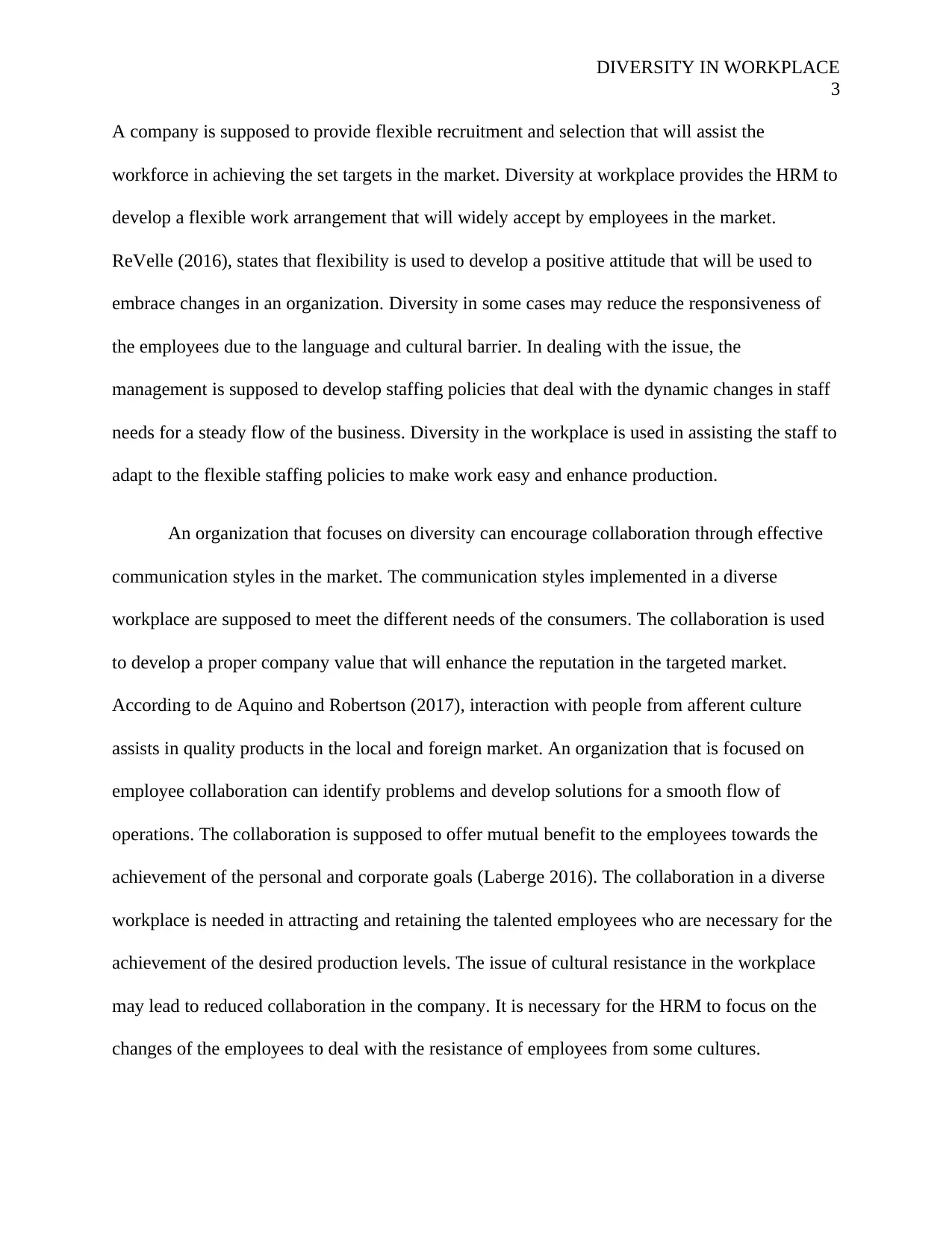
DIVERSITY IN WORKPLACE
3
A company is supposed to provide flexible recruitment and selection that will assist the
workforce in achieving the set targets in the market. Diversity at workplace provides the HRM to
develop a flexible work arrangement that will widely accept by employees in the market.
ReVelle (2016), states that flexibility is used to develop a positive attitude that will be used to
embrace changes in an organization. Diversity in some cases may reduce the responsiveness of
the employees due to the language and cultural barrier. In dealing with the issue, the
management is supposed to develop staffing policies that deal with the dynamic changes in staff
needs for a steady flow of the business. Diversity in the workplace is used in assisting the staff to
adapt to the flexible staffing policies to make work easy and enhance production.
An organization that focuses on diversity can encourage collaboration through effective
communication styles in the market. The communication styles implemented in a diverse
workplace are supposed to meet the different needs of the consumers. The collaboration is used
to develop a proper company value that will enhance the reputation in the targeted market.
According to de Aquino and Robertson (2017), interaction with people from afferent culture
assists in quality products in the local and foreign market. An organization that is focused on
employee collaboration can identify problems and develop solutions for a smooth flow of
operations. The collaboration is supposed to offer mutual benefit to the employees towards the
achievement of the personal and corporate goals (Laberge 2016). The collaboration in a diverse
workplace is needed in attracting and retaining the talented employees who are necessary for the
achievement of the desired production levels. The issue of cultural resistance in the workplace
may lead to reduced collaboration in the company. It is necessary for the HRM to focus on the
changes of the employees to deal with the resistance of employees from some cultures.
3
A company is supposed to provide flexible recruitment and selection that will assist the
workforce in achieving the set targets in the market. Diversity at workplace provides the HRM to
develop a flexible work arrangement that will widely accept by employees in the market.
ReVelle (2016), states that flexibility is used to develop a positive attitude that will be used to
embrace changes in an organization. Diversity in some cases may reduce the responsiveness of
the employees due to the language and cultural barrier. In dealing with the issue, the
management is supposed to develop staffing policies that deal with the dynamic changes in staff
needs for a steady flow of the business. Diversity in the workplace is used in assisting the staff to
adapt to the flexible staffing policies to make work easy and enhance production.
An organization that focuses on diversity can encourage collaboration through effective
communication styles in the market. The communication styles implemented in a diverse
workplace are supposed to meet the different needs of the consumers. The collaboration is used
to develop a proper company value that will enhance the reputation in the targeted market.
According to de Aquino and Robertson (2017), interaction with people from afferent culture
assists in quality products in the local and foreign market. An organization that is focused on
employee collaboration can identify problems and develop solutions for a smooth flow of
operations. The collaboration is supposed to offer mutual benefit to the employees towards the
achievement of the personal and corporate goals (Laberge 2016). The collaboration in a diverse
workplace is needed in attracting and retaining the talented employees who are necessary for the
achievement of the desired production levels. The issue of cultural resistance in the workplace
may lead to reduced collaboration in the company. It is necessary for the HRM to focus on the
changes of the employees to deal with the resistance of employees from some cultures.
⊘ This is a preview!⊘
Do you want full access?
Subscribe today to unlock all pages.

Trusted by 1+ million students worldwide
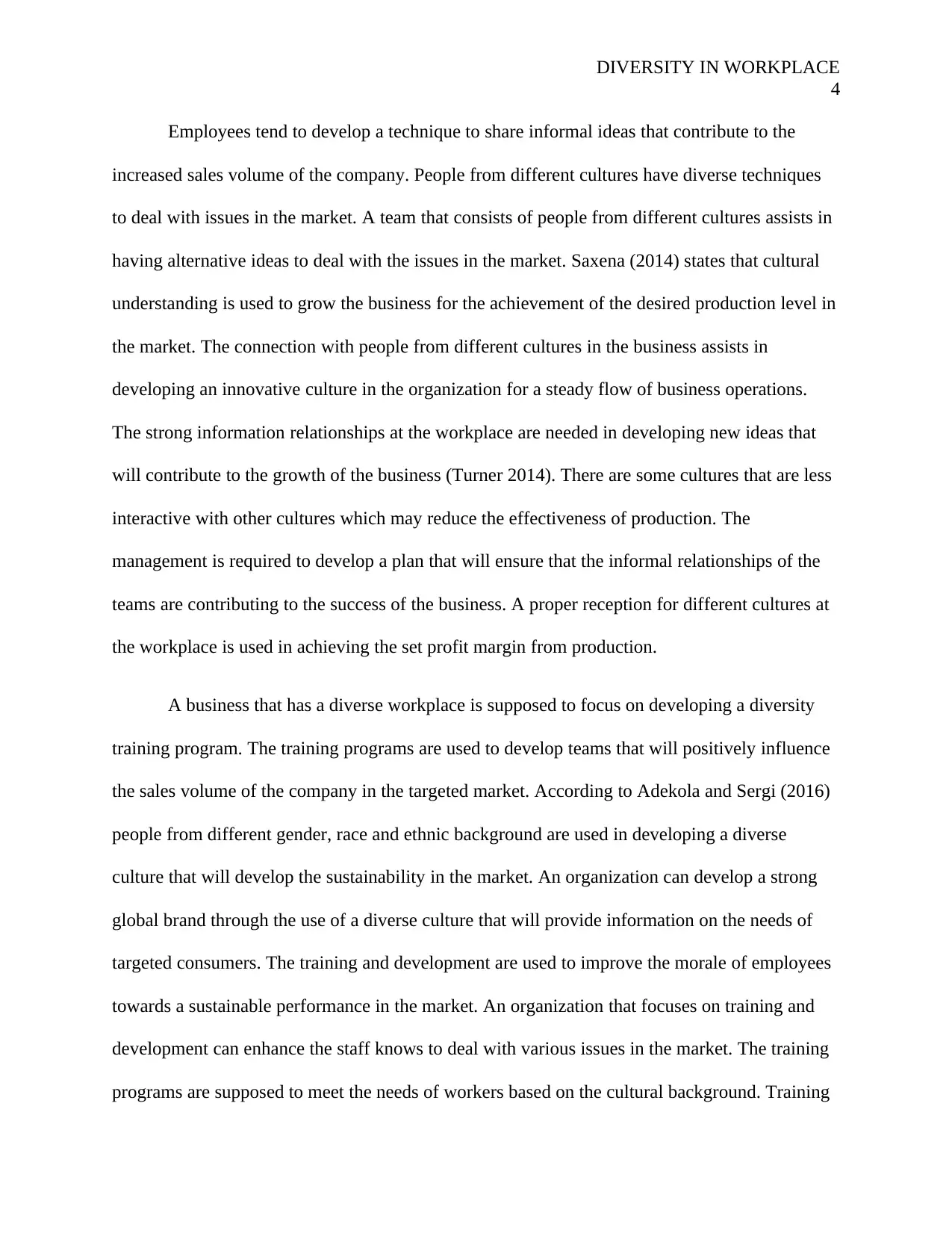
DIVERSITY IN WORKPLACE
4
Employees tend to develop a technique to share informal ideas that contribute to the
increased sales volume of the company. People from different cultures have diverse techniques
to deal with issues in the market. A team that consists of people from different cultures assists in
having alternative ideas to deal with the issues in the market. Saxena (2014) states that cultural
understanding is used to grow the business for the achievement of the desired production level in
the market. The connection with people from different cultures in the business assists in
developing an innovative culture in the organization for a steady flow of business operations.
The strong information relationships at the workplace are needed in developing new ideas that
will contribute to the growth of the business (Turner 2014). There are some cultures that are less
interactive with other cultures which may reduce the effectiveness of production. The
management is required to develop a plan that will ensure that the informal relationships of the
teams are contributing to the success of the business. A proper reception for different cultures at
the workplace is used in achieving the set profit margin from production.
A business that has a diverse workplace is supposed to focus on developing a diversity
training program. The training programs are used to develop teams that will positively influence
the sales volume of the company in the targeted market. According to Adekola and Sergi (2016)
people from different gender, race and ethnic background are used in developing a diverse
culture that will develop the sustainability in the market. An organization can develop a strong
global brand through the use of a diverse culture that will provide information on the needs of
targeted consumers. The training and development are used to improve the morale of employees
towards a sustainable performance in the market. An organization that focuses on training and
development can enhance the staff knows to deal with various issues in the market. The training
programs are supposed to meet the needs of workers based on the cultural background. Training
4
Employees tend to develop a technique to share informal ideas that contribute to the
increased sales volume of the company. People from different cultures have diverse techniques
to deal with issues in the market. A team that consists of people from different cultures assists in
having alternative ideas to deal with the issues in the market. Saxena (2014) states that cultural
understanding is used to grow the business for the achievement of the desired production level in
the market. The connection with people from different cultures in the business assists in
developing an innovative culture in the organization for a steady flow of business operations.
The strong information relationships at the workplace are needed in developing new ideas that
will contribute to the growth of the business (Turner 2014). There are some cultures that are less
interactive with other cultures which may reduce the effectiveness of production. The
management is required to develop a plan that will ensure that the informal relationships of the
teams are contributing to the success of the business. A proper reception for different cultures at
the workplace is used in achieving the set profit margin from production.
A business that has a diverse workplace is supposed to focus on developing a diversity
training program. The training programs are used to develop teams that will positively influence
the sales volume of the company in the targeted market. According to Adekola and Sergi (2016)
people from different gender, race and ethnic background are used in developing a diverse
culture that will develop the sustainability in the market. An organization can develop a strong
global brand through the use of a diverse culture that will provide information on the needs of
targeted consumers. The training and development are used to improve the morale of employees
towards a sustainable performance in the market. An organization that focuses on training and
development can enhance the staff knows to deal with various issues in the market. The training
programs are supposed to meet the needs of workers based on the cultural background. Training
Paraphrase This Document
Need a fresh take? Get an instant paraphrase of this document with our AI Paraphraser
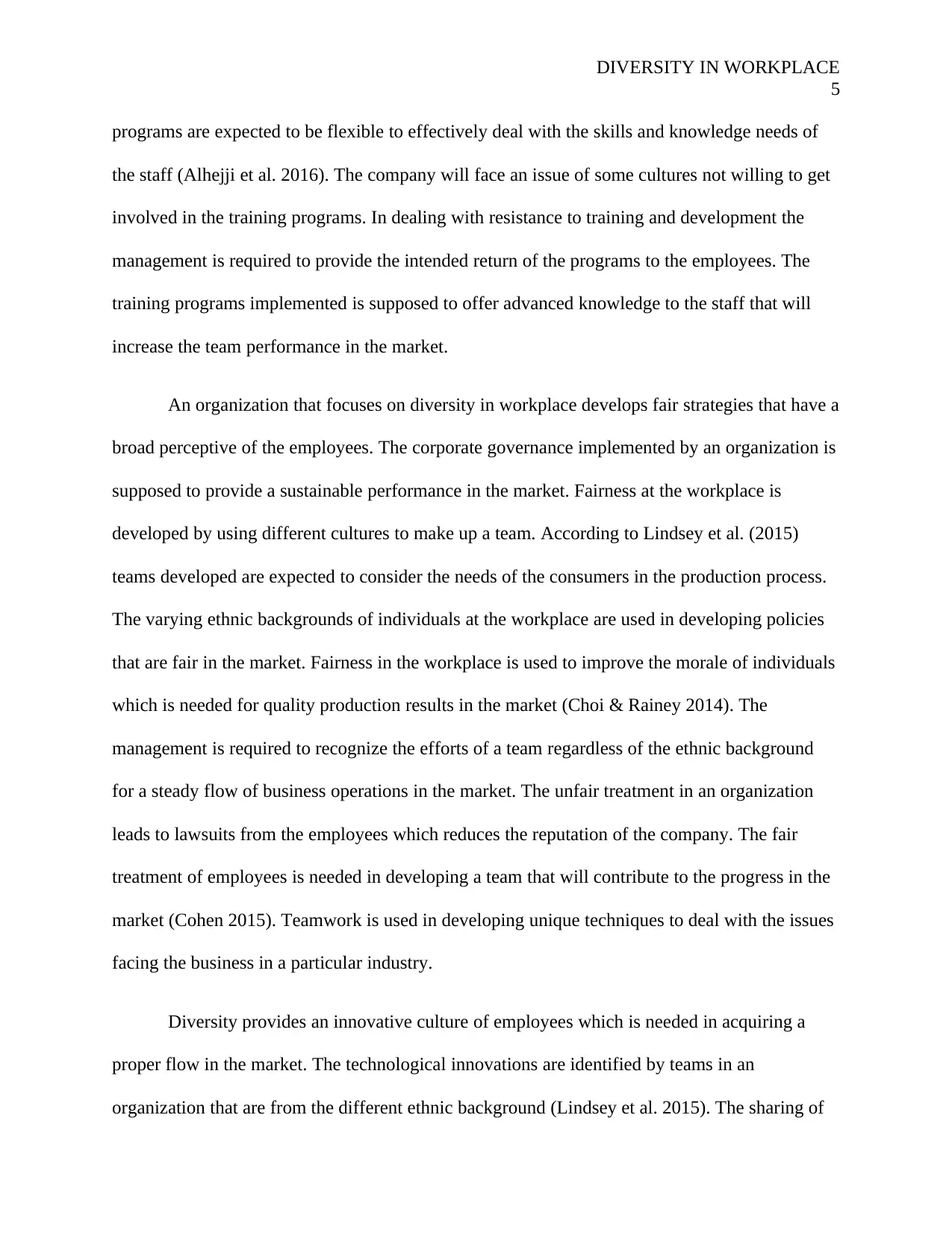
DIVERSITY IN WORKPLACE
5
programs are expected to be flexible to effectively deal with the skills and knowledge needs of
the staff (Alhejji et al. 2016). The company will face an issue of some cultures not willing to get
involved in the training programs. In dealing with resistance to training and development the
management is required to provide the intended return of the programs to the employees. The
training programs implemented is supposed to offer advanced knowledge to the staff that will
increase the team performance in the market.
An organization that focuses on diversity in workplace develops fair strategies that have a
broad perceptive of the employees. The corporate governance implemented by an organization is
supposed to provide a sustainable performance in the market. Fairness at the workplace is
developed by using different cultures to make up a team. According to Lindsey et al. (2015)
teams developed are expected to consider the needs of the consumers in the production process.
The varying ethnic backgrounds of individuals at the workplace are used in developing policies
that are fair in the market. Fairness in the workplace is used to improve the morale of individuals
which is needed for quality production results in the market (Choi & Rainey 2014). The
management is required to recognize the efforts of a team regardless of the ethnic background
for a steady flow of business operations in the market. The unfair treatment in an organization
leads to lawsuits from the employees which reduces the reputation of the company. The fair
treatment of employees is needed in developing a team that will contribute to the progress in the
market (Cohen 2015). Teamwork is used in developing unique techniques to deal with the issues
facing the business in a particular industry.
Diversity provides an innovative culture of employees which is needed in acquiring a
proper flow in the market. The technological innovations are identified by teams in an
organization that are from the different ethnic background (Lindsey et al. 2015). The sharing of
5
programs are expected to be flexible to effectively deal with the skills and knowledge needs of
the staff (Alhejji et al. 2016). The company will face an issue of some cultures not willing to get
involved in the training programs. In dealing with resistance to training and development the
management is required to provide the intended return of the programs to the employees. The
training programs implemented is supposed to offer advanced knowledge to the staff that will
increase the team performance in the market.
An organization that focuses on diversity in workplace develops fair strategies that have a
broad perceptive of the employees. The corporate governance implemented by an organization is
supposed to provide a sustainable performance in the market. Fairness at the workplace is
developed by using different cultures to make up a team. According to Lindsey et al. (2015)
teams developed are expected to consider the needs of the consumers in the production process.
The varying ethnic backgrounds of individuals at the workplace are used in developing policies
that are fair in the market. Fairness in the workplace is used to improve the morale of individuals
which is needed for quality production results in the market (Choi & Rainey 2014). The
management is required to recognize the efforts of a team regardless of the ethnic background
for a steady flow of business operations in the market. The unfair treatment in an organization
leads to lawsuits from the employees which reduces the reputation of the company. The fair
treatment of employees is needed in developing a team that will contribute to the progress in the
market (Cohen 2015). Teamwork is used in developing unique techniques to deal with the issues
facing the business in a particular industry.
Diversity provides an innovative culture of employees which is needed in acquiring a
proper flow in the market. The technological innovations are identified by teams in an
organization that are from the different ethnic background (Lindsey et al. 2015). The sharing of
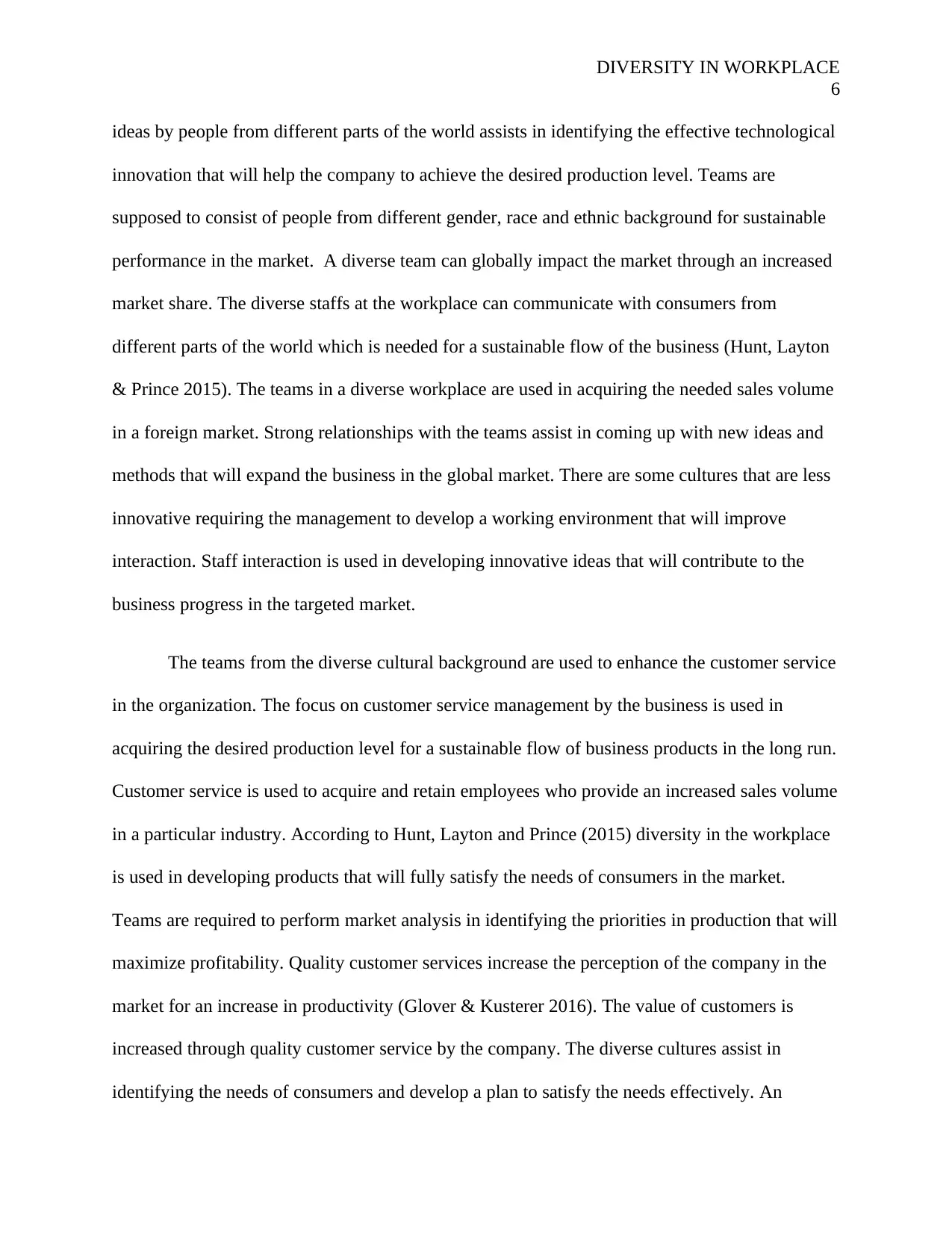
DIVERSITY IN WORKPLACE
6
ideas by people from different parts of the world assists in identifying the effective technological
innovation that will help the company to achieve the desired production level. Teams are
supposed to consist of people from different gender, race and ethnic background for sustainable
performance in the market. A diverse team can globally impact the market through an increased
market share. The diverse staffs at the workplace can communicate with consumers from
different parts of the world which is needed for a sustainable flow of the business (Hunt, Layton
& Prince 2015). The teams in a diverse workplace are used in acquiring the needed sales volume
in a foreign market. Strong relationships with the teams assist in coming up with new ideas and
methods that will expand the business in the global market. There are some cultures that are less
innovative requiring the management to develop a working environment that will improve
interaction. Staff interaction is used in developing innovative ideas that will contribute to the
business progress in the targeted market.
The teams from the diverse cultural background are used to enhance the customer service
in the organization. The focus on customer service management by the business is used in
acquiring the desired production level for a sustainable flow of business products in the long run.
Customer service is used to acquire and retain employees who provide an increased sales volume
in a particular industry. According to Hunt, Layton and Prince (2015) diversity in the workplace
is used in developing products that will fully satisfy the needs of consumers in the market.
Teams are required to perform market analysis in identifying the priorities in production that will
maximize profitability. Quality customer services increase the perception of the company in the
market for an increase in productivity (Glover & Kusterer 2016). The value of customers is
increased through quality customer service by the company. The diverse cultures assist in
identifying the needs of consumers and develop a plan to satisfy the needs effectively. An
6
ideas by people from different parts of the world assists in identifying the effective technological
innovation that will help the company to achieve the desired production level. Teams are
supposed to consist of people from different gender, race and ethnic background for sustainable
performance in the market. A diverse team can globally impact the market through an increased
market share. The diverse staffs at the workplace can communicate with consumers from
different parts of the world which is needed for a sustainable flow of the business (Hunt, Layton
& Prince 2015). The teams in a diverse workplace are used in acquiring the needed sales volume
in a foreign market. Strong relationships with the teams assist in coming up with new ideas and
methods that will expand the business in the global market. There are some cultures that are less
innovative requiring the management to develop a working environment that will improve
interaction. Staff interaction is used in developing innovative ideas that will contribute to the
business progress in the targeted market.
The teams from the diverse cultural background are used to enhance the customer service
in the organization. The focus on customer service management by the business is used in
acquiring the desired production level for a sustainable flow of business products in the long run.
Customer service is used to acquire and retain employees who provide an increased sales volume
in a particular industry. According to Hunt, Layton and Prince (2015) diversity in the workplace
is used in developing products that will fully satisfy the needs of consumers in the market.
Teams are required to perform market analysis in identifying the priorities in production that will
maximize profitability. Quality customer services increase the perception of the company in the
market for an increase in productivity (Glover & Kusterer 2016). The value of customers is
increased through quality customer service by the company. The diverse cultures assist in
identifying the needs of consumers and develop a plan to satisfy the needs effectively. An
⊘ This is a preview!⊘
Do you want full access?
Subscribe today to unlock all pages.

Trusted by 1+ million students worldwide
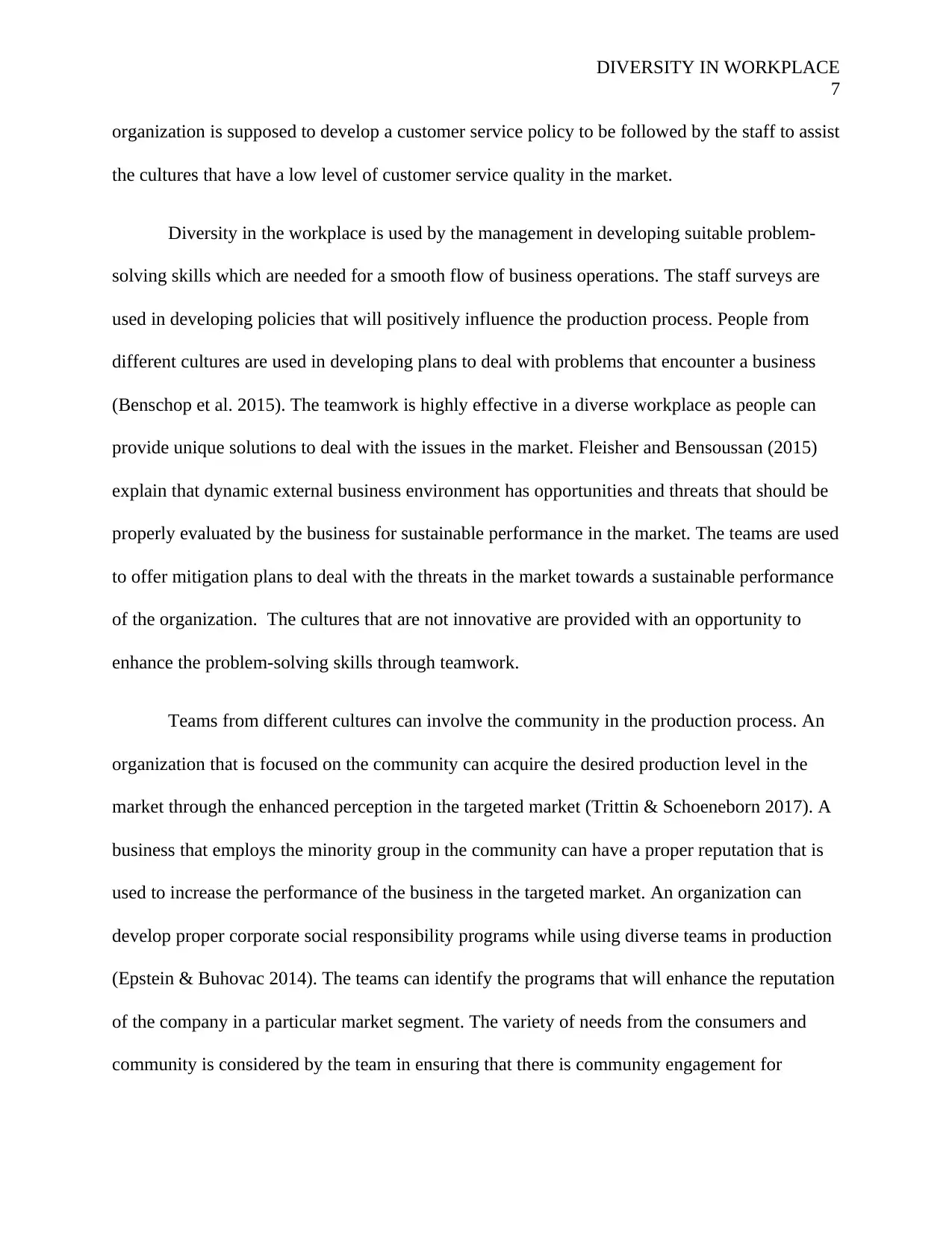
DIVERSITY IN WORKPLACE
7
organization is supposed to develop a customer service policy to be followed by the staff to assist
the cultures that have a low level of customer service quality in the market.
Diversity in the workplace is used by the management in developing suitable problem-
solving skills which are needed for a smooth flow of business operations. The staff surveys are
used in developing policies that will positively influence the production process. People from
different cultures are used in developing plans to deal with problems that encounter a business
(Benschop et al. 2015). The teamwork is highly effective in a diverse workplace as people can
provide unique solutions to deal with the issues in the market. Fleisher and Bensoussan (2015)
explain that dynamic external business environment has opportunities and threats that should be
properly evaluated by the business for sustainable performance in the market. The teams are used
to offer mitigation plans to deal with the threats in the market towards a sustainable performance
of the organization. The cultures that are not innovative are provided with an opportunity to
enhance the problem-solving skills through teamwork.
Teams from different cultures can involve the community in the production process. An
organization that is focused on the community can acquire the desired production level in the
market through the enhanced perception in the targeted market (Trittin & Schoeneborn 2017). A
business that employs the minority group in the community can have a proper reputation that is
used to increase the performance of the business in the targeted market. An organization can
develop proper corporate social responsibility programs while using diverse teams in production
(Epstein & Buhovac 2014). The teams can identify the programs that will enhance the reputation
of the company in a particular market segment. The variety of needs from the consumers and
community is considered by the team in ensuring that there is community engagement for
7
organization is supposed to develop a customer service policy to be followed by the staff to assist
the cultures that have a low level of customer service quality in the market.
Diversity in the workplace is used by the management in developing suitable problem-
solving skills which are needed for a smooth flow of business operations. The staff surveys are
used in developing policies that will positively influence the production process. People from
different cultures are used in developing plans to deal with problems that encounter a business
(Benschop et al. 2015). The teamwork is highly effective in a diverse workplace as people can
provide unique solutions to deal with the issues in the market. Fleisher and Bensoussan (2015)
explain that dynamic external business environment has opportunities and threats that should be
properly evaluated by the business for sustainable performance in the market. The teams are used
to offer mitigation plans to deal with the threats in the market towards a sustainable performance
of the organization. The cultures that are not innovative are provided with an opportunity to
enhance the problem-solving skills through teamwork.
Teams from different cultures can involve the community in the production process. An
organization that is focused on the community can acquire the desired production level in the
market through the enhanced perception in the targeted market (Trittin & Schoeneborn 2017). A
business that employs the minority group in the community can have a proper reputation that is
used to increase the performance of the business in the targeted market. An organization can
develop proper corporate social responsibility programs while using diverse teams in production
(Epstein & Buhovac 2014). The teams can identify the programs that will enhance the reputation
of the company in a particular market segment. The variety of needs from the consumers and
community is considered by the team in ensuring that there is community engagement for
Paraphrase This Document
Need a fresh take? Get an instant paraphrase of this document with our AI Paraphraser
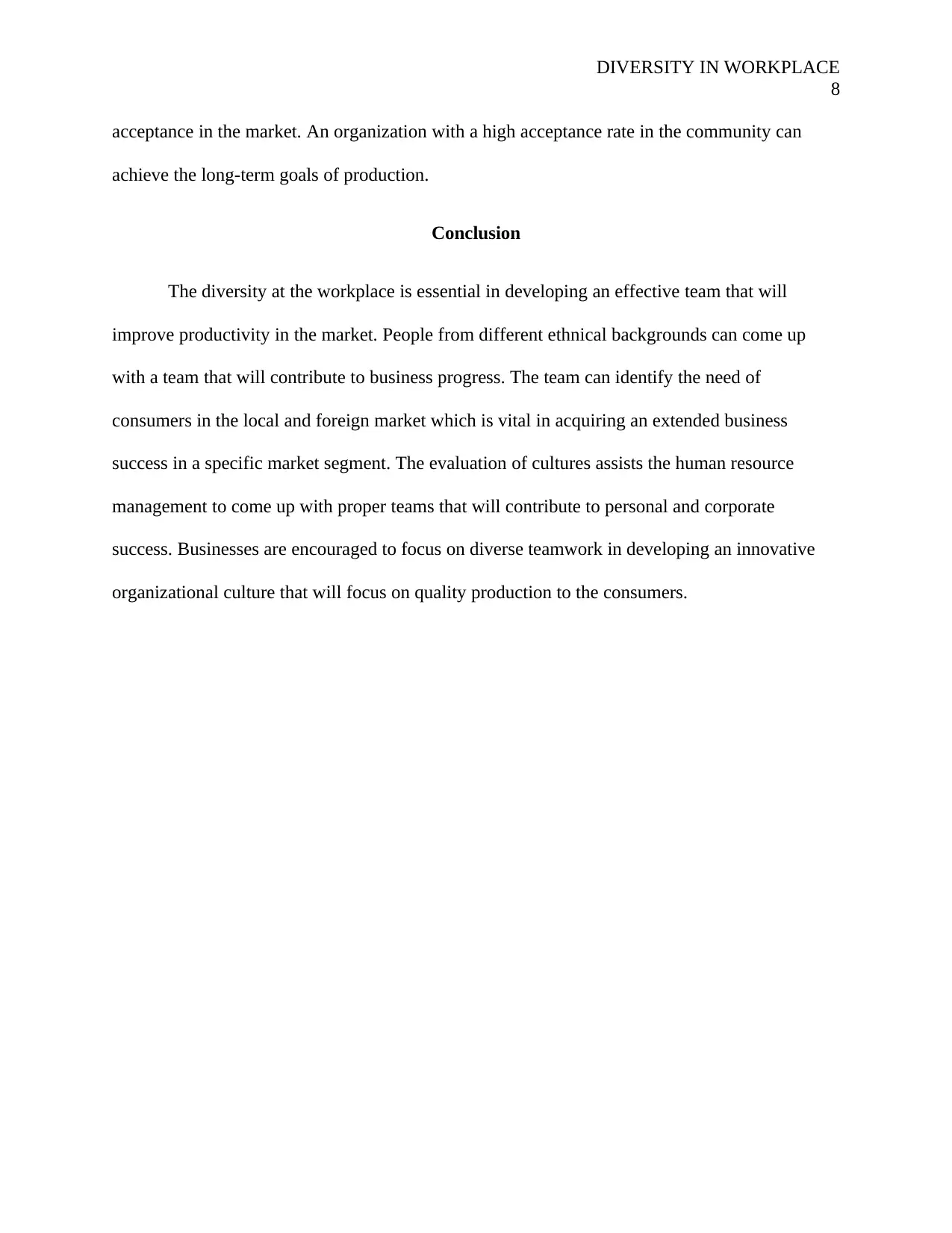
DIVERSITY IN WORKPLACE
8
acceptance in the market. An organization with a high acceptance rate in the community can
achieve the long-term goals of production.
Conclusion
The diversity at the workplace is essential in developing an effective team that will
improve productivity in the market. People from different ethnical backgrounds can come up
with a team that will contribute to business progress. The team can identify the need of
consumers in the local and foreign market which is vital in acquiring an extended business
success in a specific market segment. The evaluation of cultures assists the human resource
management to come up with proper teams that will contribute to personal and corporate
success. Businesses are encouraged to focus on diverse teamwork in developing an innovative
organizational culture that will focus on quality production to the consumers.
8
acceptance in the market. An organization with a high acceptance rate in the community can
achieve the long-term goals of production.
Conclusion
The diversity at the workplace is essential in developing an effective team that will
improve productivity in the market. People from different ethnical backgrounds can come up
with a team that will contribute to business progress. The team can identify the need of
consumers in the local and foreign market which is vital in acquiring an extended business
success in a specific market segment. The evaluation of cultures assists the human resource
management to come up with proper teams that will contribute to personal and corporate
success. Businesses are encouraged to focus on diverse teamwork in developing an innovative
organizational culture that will focus on quality production to the consumers.
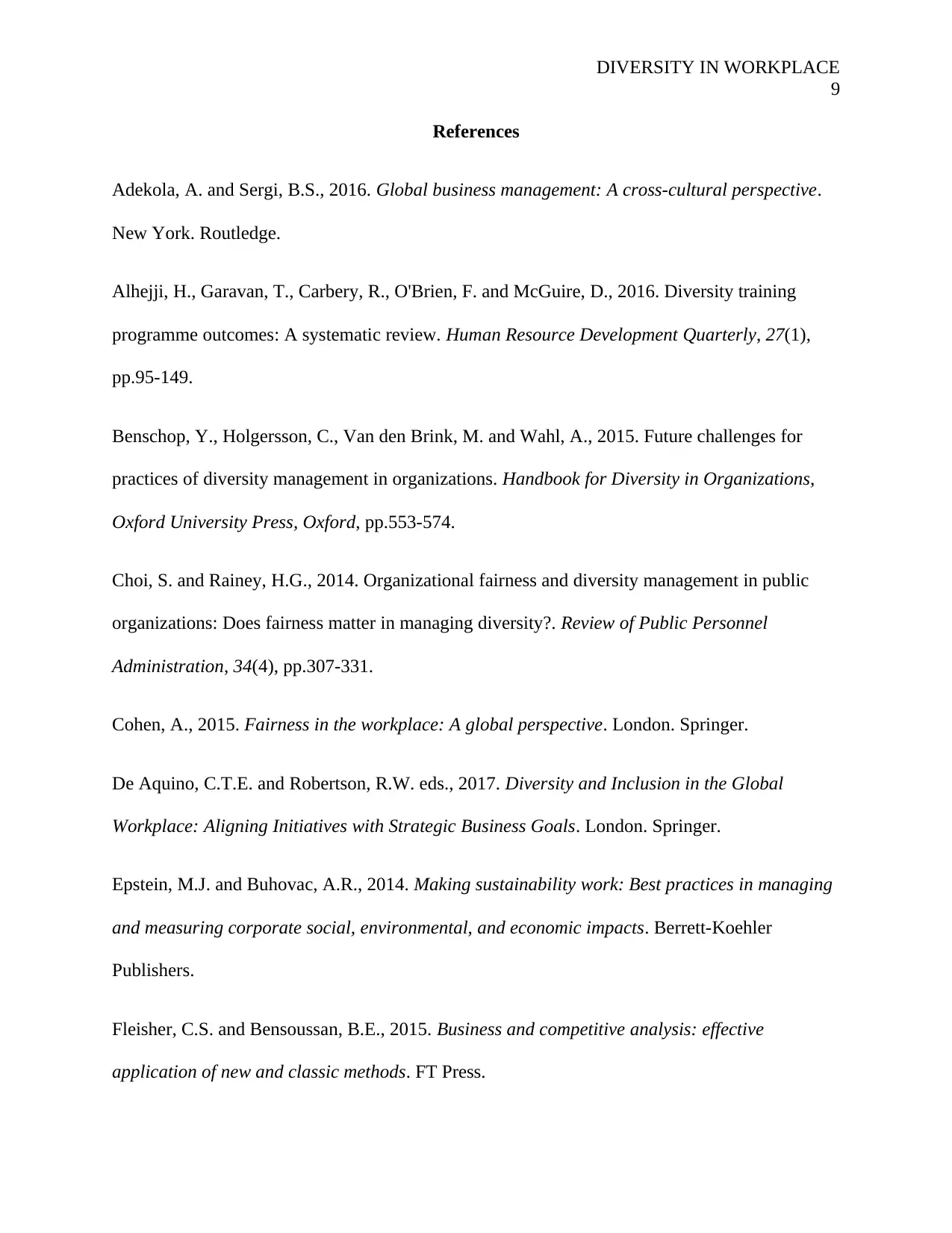
DIVERSITY IN WORKPLACE
9
References
Adekola, A. and Sergi, B.S., 2016. Global business management: A cross-cultural perspective.
New York. Routledge.
Alhejji, H., Garavan, T., Carbery, R., O'Brien, F. and McGuire, D., 2016. Diversity training
programme outcomes: A systematic review. Human Resource Development Quarterly, 27(1),
pp.95-149.
Benschop, Y., Holgersson, C., Van den Brink, M. and Wahl, A., 2015. Future challenges for
practices of diversity management in organizations. Handbook for Diversity in Organizations,
Oxford University Press, Oxford, pp.553-574.
Choi, S. and Rainey, H.G., 2014. Organizational fairness and diversity management in public
organizations: Does fairness matter in managing diversity?. Review of Public Personnel
Administration, 34(4), pp.307-331.
Cohen, A., 2015. Fairness in the workplace: A global perspective. London. Springer.
De Aquino, C.T.E. and Robertson, R.W. eds., 2017. Diversity and Inclusion in the Global
Workplace: Aligning Initiatives with Strategic Business Goals. London. Springer.
Epstein, M.J. and Buhovac, A.R., 2014. Making sustainability work: Best practices in managing
and measuring corporate social, environmental, and economic impacts. Berrett-Koehler
Publishers.
Fleisher, C.S. and Bensoussan, B.E., 2015. Business and competitive analysis: effective
application of new and classic methods. FT Press.
9
References
Adekola, A. and Sergi, B.S., 2016. Global business management: A cross-cultural perspective.
New York. Routledge.
Alhejji, H., Garavan, T., Carbery, R., O'Brien, F. and McGuire, D., 2016. Diversity training
programme outcomes: A systematic review. Human Resource Development Quarterly, 27(1),
pp.95-149.
Benschop, Y., Holgersson, C., Van den Brink, M. and Wahl, A., 2015. Future challenges for
practices of diversity management in organizations. Handbook for Diversity in Organizations,
Oxford University Press, Oxford, pp.553-574.
Choi, S. and Rainey, H.G., 2014. Organizational fairness and diversity management in public
organizations: Does fairness matter in managing diversity?. Review of Public Personnel
Administration, 34(4), pp.307-331.
Cohen, A., 2015. Fairness in the workplace: A global perspective. London. Springer.
De Aquino, C.T.E. and Robertson, R.W. eds., 2017. Diversity and Inclusion in the Global
Workplace: Aligning Initiatives with Strategic Business Goals. London. Springer.
Epstein, M.J. and Buhovac, A.R., 2014. Making sustainability work: Best practices in managing
and measuring corporate social, environmental, and economic impacts. Berrett-Koehler
Publishers.
Fleisher, C.S. and Bensoussan, B.E., 2015. Business and competitive analysis: effective
application of new and classic methods. FT Press.
⊘ This is a preview!⊘
Do you want full access?
Subscribe today to unlock all pages.

Trusted by 1+ million students worldwide
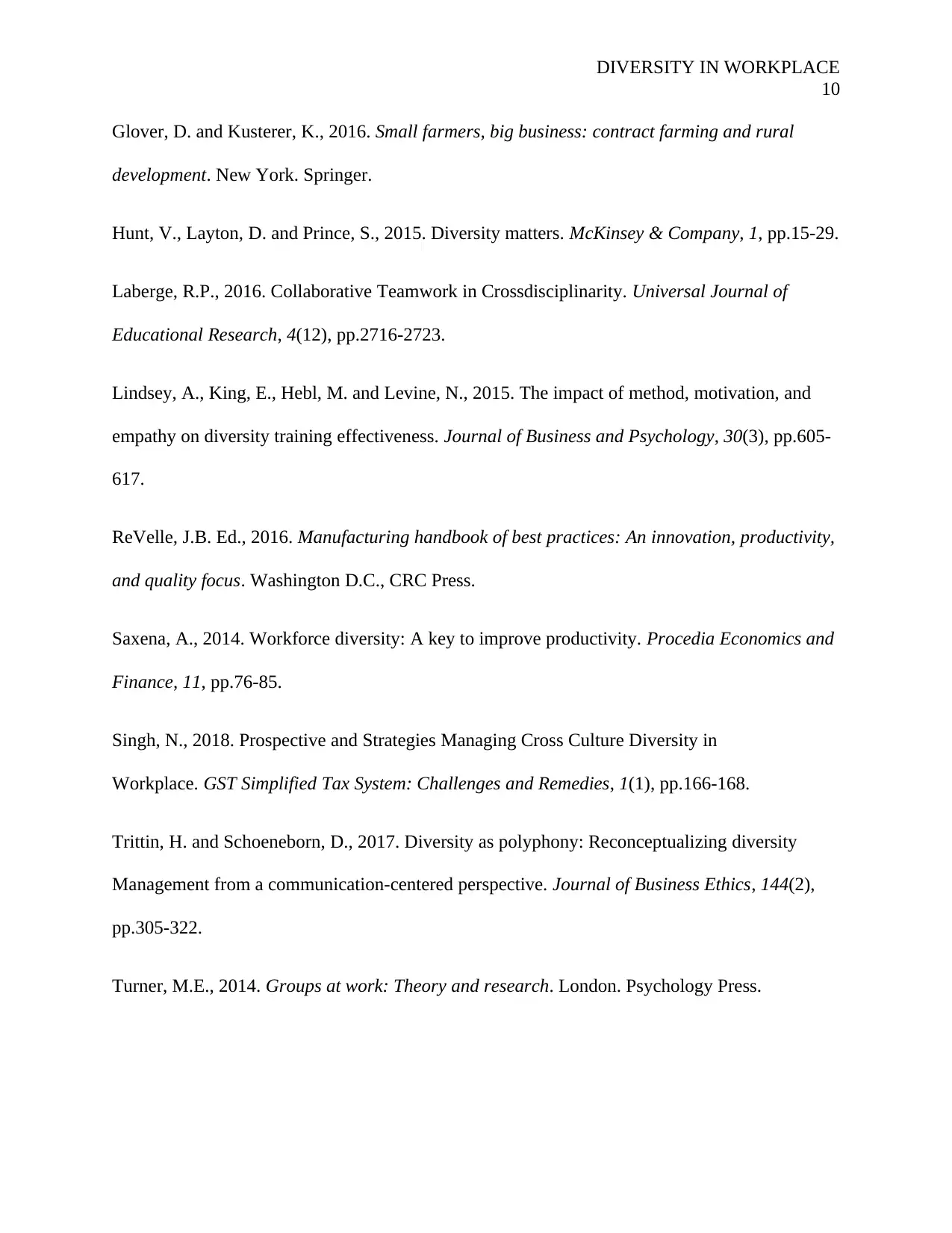
DIVERSITY IN WORKPLACE
10
Glover, D. and Kusterer, K., 2016. Small farmers, big business: contract farming and rural
development. New York. Springer.
Hunt, V., Layton, D. and Prince, S., 2015. Diversity matters. McKinsey & Company, 1, pp.15-29.
Laberge, R.P., 2016. Collaborative Teamwork in Crossdisciplinarity. Universal Journal of
Educational Research, 4(12), pp.2716-2723.
Lindsey, A., King, E., Hebl, M. and Levine, N., 2015. The impact of method, motivation, and
empathy on diversity training effectiveness. Journal of Business and Psychology, 30(3), pp.605-
617.
ReVelle, J.B. Ed., 2016. Manufacturing handbook of best practices: An innovation, productivity,
and quality focus. Washington D.C., CRC Press.
Saxena, A., 2014. Workforce diversity: A key to improve productivity. Procedia Economics and
Finance, 11, pp.76-85.
Singh, N., 2018. Prospective and Strategies Managing Cross Culture Diversity in
Workplace. GST Simplified Tax System: Challenges and Remedies, 1(1), pp.166-168.
Trittin, H. and Schoeneborn, D., 2017. Diversity as polyphony: Reconceptualizing diversity
Management from a communication-centered perspective. Journal of Business Ethics, 144(2),
pp.305-322.
Turner, M.E., 2014. Groups at work: Theory and research. London. Psychology Press.
10
Glover, D. and Kusterer, K., 2016. Small farmers, big business: contract farming and rural
development. New York. Springer.
Hunt, V., Layton, D. and Prince, S., 2015. Diversity matters. McKinsey & Company, 1, pp.15-29.
Laberge, R.P., 2016. Collaborative Teamwork in Crossdisciplinarity. Universal Journal of
Educational Research, 4(12), pp.2716-2723.
Lindsey, A., King, E., Hebl, M. and Levine, N., 2015. The impact of method, motivation, and
empathy on diversity training effectiveness. Journal of Business and Psychology, 30(3), pp.605-
617.
ReVelle, J.B. Ed., 2016. Manufacturing handbook of best practices: An innovation, productivity,
and quality focus. Washington D.C., CRC Press.
Saxena, A., 2014. Workforce diversity: A key to improve productivity. Procedia Economics and
Finance, 11, pp.76-85.
Singh, N., 2018. Prospective and Strategies Managing Cross Culture Diversity in
Workplace. GST Simplified Tax System: Challenges and Remedies, 1(1), pp.166-168.
Trittin, H. and Schoeneborn, D., 2017. Diversity as polyphony: Reconceptualizing diversity
Management from a communication-centered perspective. Journal of Business Ethics, 144(2),
pp.305-322.
Turner, M.E., 2014. Groups at work: Theory and research. London. Psychology Press.
1 out of 10
Related Documents
Your All-in-One AI-Powered Toolkit for Academic Success.
+13062052269
info@desklib.com
Available 24*7 on WhatsApp / Email
![[object Object]](/_next/static/media/star-bottom.7253800d.svg)
Unlock your academic potential
Copyright © 2020–2025 A2Z Services. All Rights Reserved. Developed and managed by ZUCOL.




